Step-by-Step Guide to Training AI Chatbots: A Complete Guide
Implement these steps for training AI chatbots. Get insights and information on how to train AI bots efficiently for optimal performance.

The demand for training AI chatbots to deliver engaging and personalized interactions is growing rapidly. AI chatbots have become indispensable tools across various industries, enhancing customer service, automating complex tasks, and improving user experiences. Businesses now leverage artificial intelligence and natural language processing to interpret user input and provide accurate responses. Understanding user intents and delivering relevant information quickly has transformed how companies handle customer queries and improve customer satisfaction.
At Kindroid, we revolutionize chatbot development by continuously improving specific chatbots designed for diverse applications. Unlike traditional chatbots, our bots adapt to user needs, responding to user’s questions with the right tone of voice and context. We utilize machine learning to train language models that evolve based on user messages and interactions. This process ensures that our chatbots maintain a natural conversational flow, enhancing the overall user experience.
Following our best practice, we've put together this guide that explores the step-by-step process of training AI chatbots. At the end of this blog, you will understand how to train specific chatbots, ensuring they perform effectively and provide exceptional customer experiences.
Let's jump in!
Essential Tools for AI Chatbot Training
Training AI chatbots requires a range of specialized tools. These tools streamline the process, ensuring the chatbot becomes more effective and responsive. Below are five essential tools that every developer should consider.
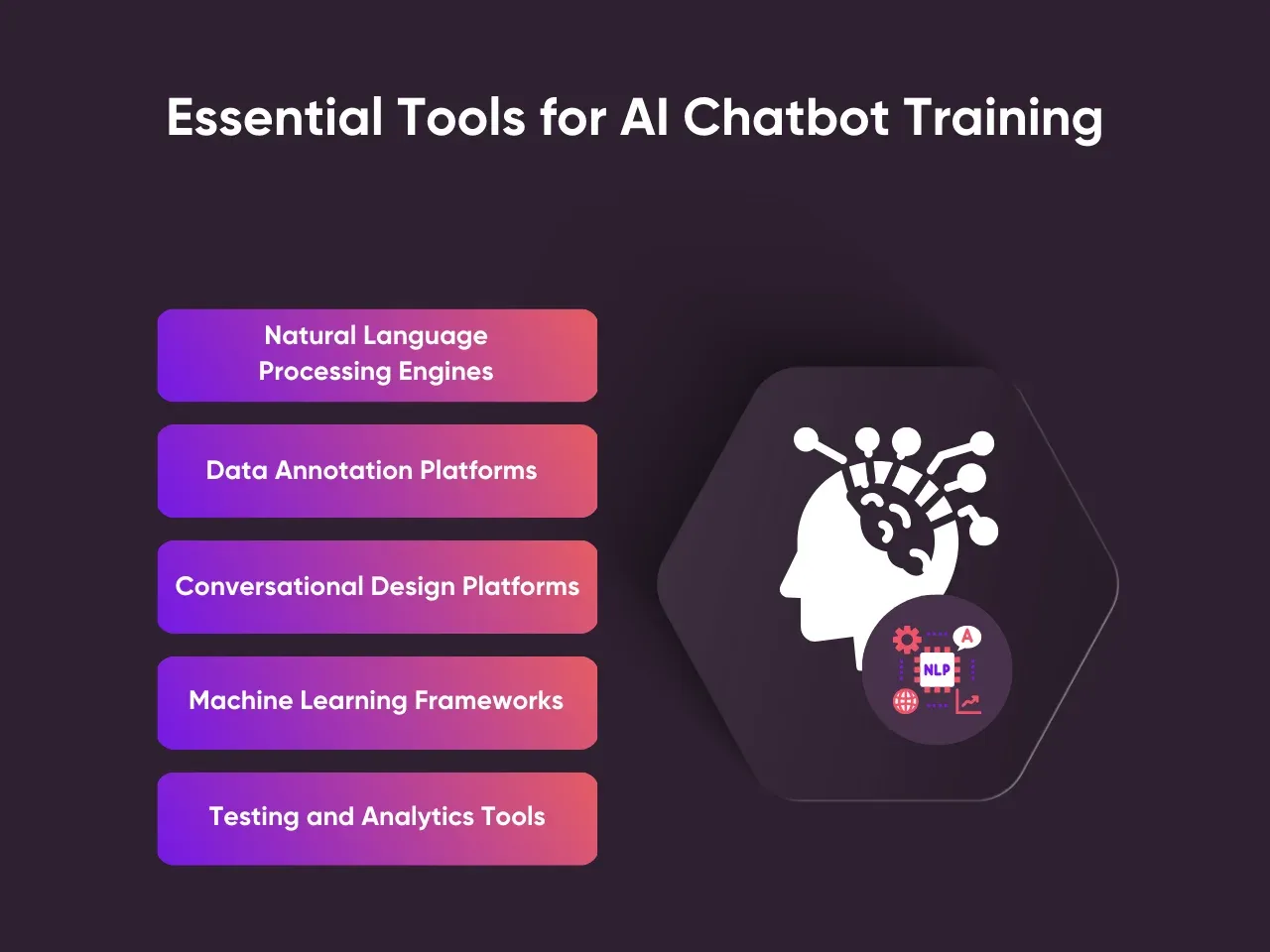
- Natural Language Processing (NLP) Engines: NLP engines are crucial for training AI chatbots to understand and process human language. Popular options include Google's Dialogflow and Microsoft's Azure Bot Service, which help the chatbot interpret user queries and respond appropriately.
- Data Annotation Platforms: Effective chatbot training relies on high-quality data. Data annotation platforms like Labelbox and Amazon SageMaker Ground Truth assist in labeling and organizing data. This process ensures that the AI understands the context of conversations and improves its responses.
- Conversational Design Platforms: Designing smooth, logical conversation flows is vital when training AI chatbots. Tools like Voiceflow and Botmock allow developers to create and visualize these flows, ensuring the chatbot delivers coherent and engaging interactions.
- Machine Learning Frameworks: Machine learning frameworks like TensorFlow and PyTorch provide the backbone for training AI chatbots. These frameworks offer the flexibility to build, train, and deploy AI models that enhance the chatbot's performance over time.
- Testing and Analytics Tools: Continuous testing is essential for refining AI chatbot training. Tools like Botium and Chatbot Analytics provide insights into chatbot performance. These tools highlight areas for improvement, ensuring the chatbot evolves to meet user expectations.
Utilizing these tools, teams can effectively train AI chatbots to deliver enhanced, personalized experiences. Proper tool selection is crucial for developing chatbots that meet technical and user expectations.
Step-by-Step Guide to Training AI Chatbots
Effectively training AI chatbots is crucial for delivering accurate and personalized user interactions. Here is a simple five-step process to help you build a well-trained chatbot to ensure it meets your business goals and provides a seamless user experience. Let’s dive into the steps.
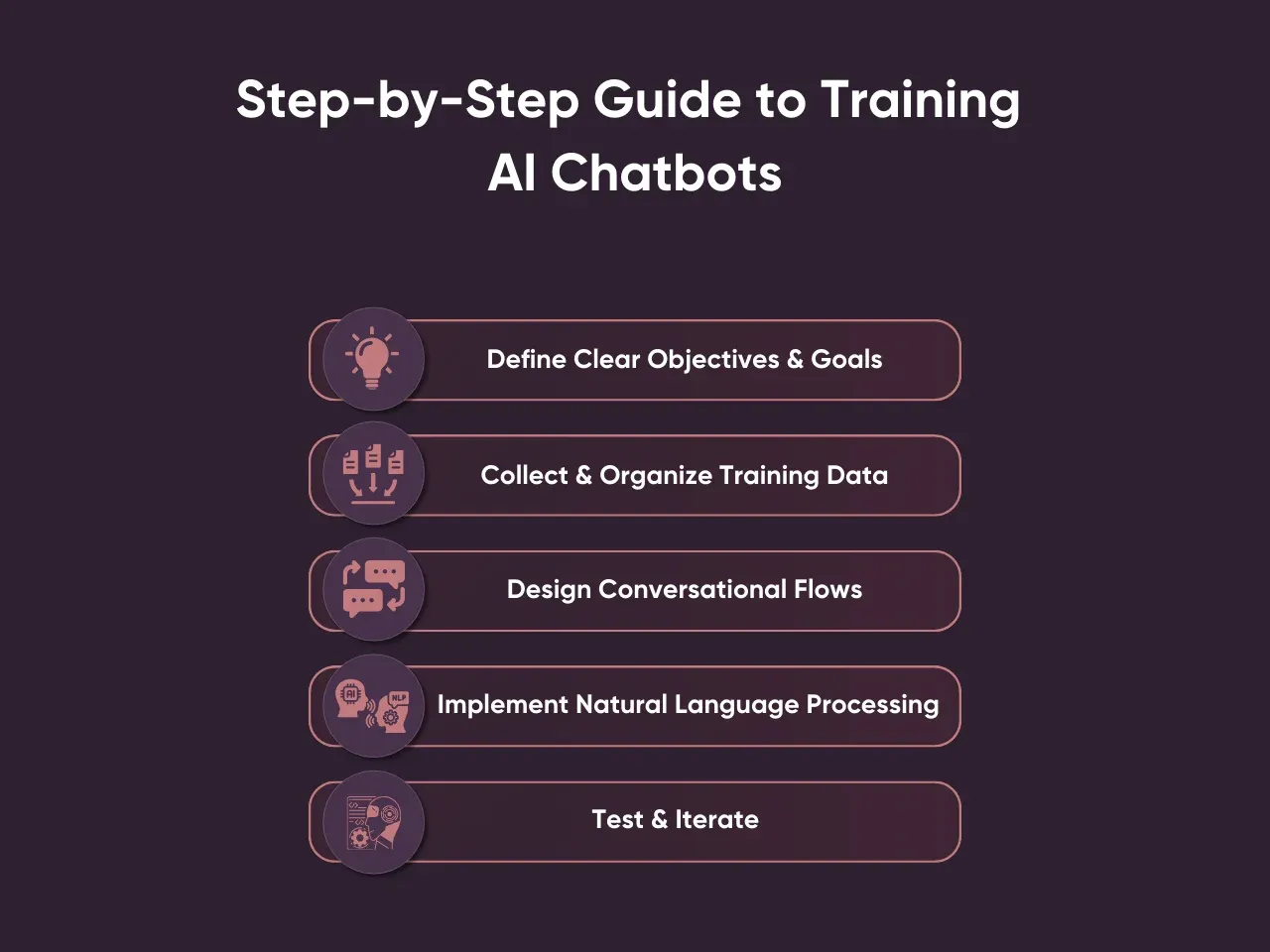
Step 1: Define Clear Objectives and Goals
Training AI chatbots starts with defining clear objectives and goals. Setting precise goals ensures the chatbot meets user expectations and aligns with the intended purpose. Whether the chatbot serves in customer service, acts as a companion, or assists with education, its objectives must reflect its role.
Define these essential goals when training AI chatbots:
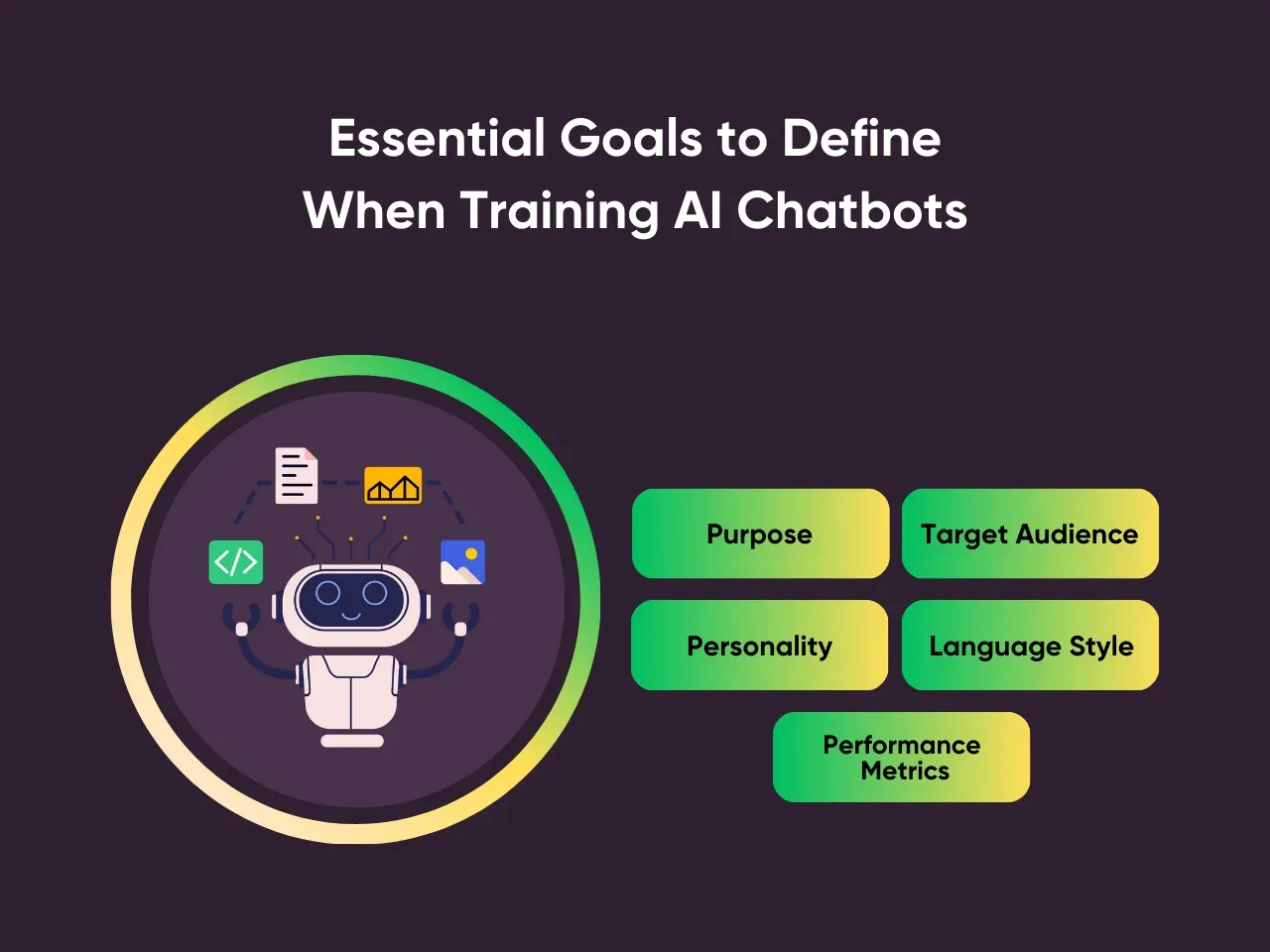
- Purpose: Determine why the chatbot exists. Is it for customer support, engagement, or something else?
- Target Audience: Identify who will interact with the chatbot and tailor its responses accordingly.
- Personality: Establish the character traits the chatbot will embody, ensuring they align with the target audience.
- Language Style: Choose a tone that fits the chatbot's personality and the audience's preferences.
- Performance Metrics: Set criteria for success, such as response accuracy and user satisfaction.
Clearly defined objectives guide the entire process of training AI chatbots. These goals influence data collection, conversational design, and natural language processing (NLP) applications. With clear objectives, the chatbot may meet its intended function. Therefore, setting these goals is critical to successfully training and deploying AI chatbots.
Step 2: Collect and Organize Training Data
The foundation of training AI chatbots effectively lies in collecting and organizing high-quality, diverse training data. With well-structured and relevant data, a chatbot can develop the ability to respond accurately or maintain a consistent community character. Therefore, gathering comprehensive datasets tailored to the specific goals of your AI chatbot is crucial.
Consider these key types of data essential for training AI chatbots:
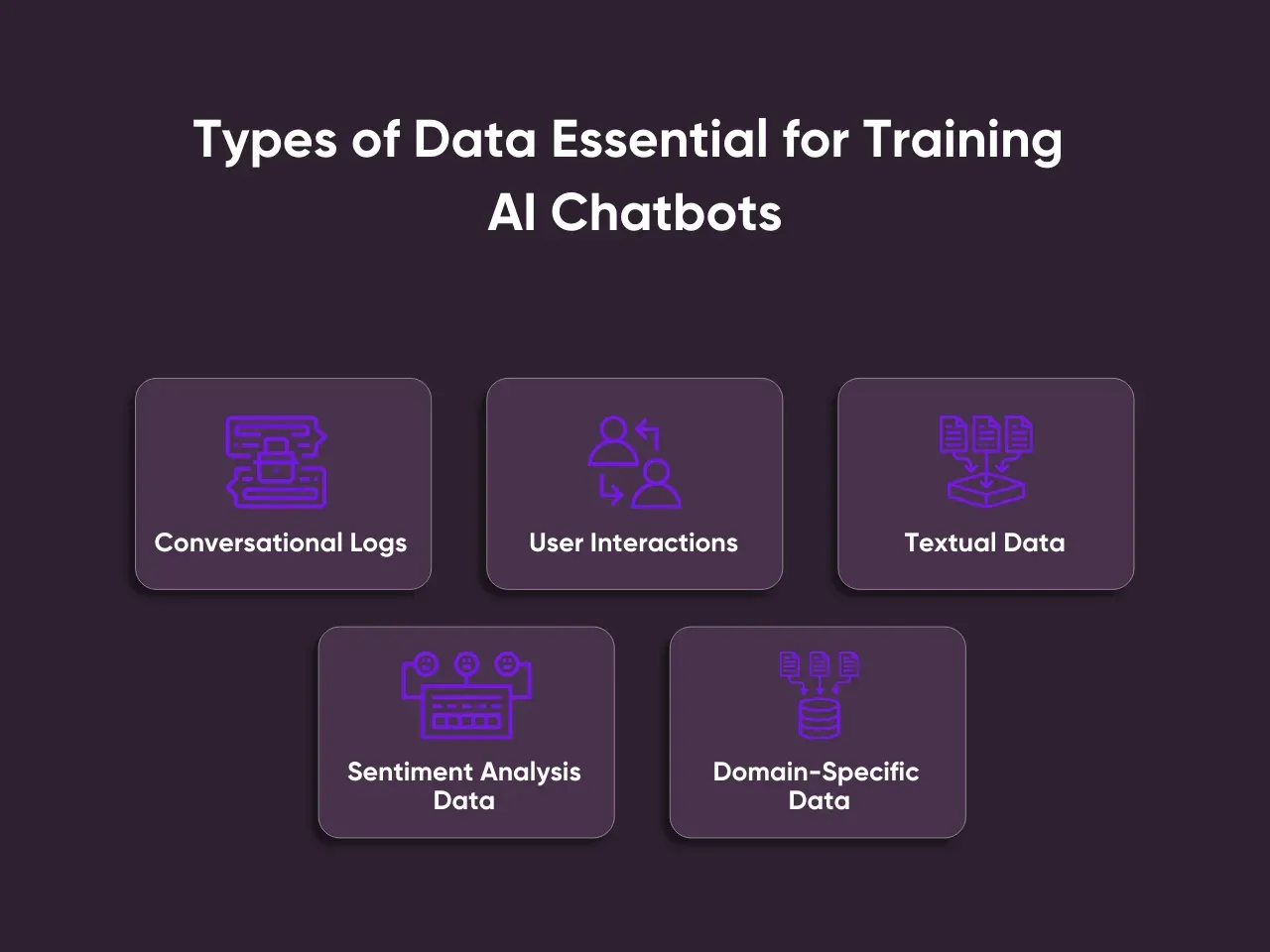
- Conversational Logs: These logs capture real-life interactions between users and chatbots or between humans. They provide context and help the AI understand natural language patterns.
- User Interactions: Data from user interactions, such as clicks, time spent, and responses, offer insights into user behavior and preferences, allowing the chatbot to adapt its responses accordingly.
- Textual Data: This includes a wide range of written content, such as articles, books, and scripts, that help the chatbot learn how to construct sentences and convey information effectively.
- Sentiment Analysis Data: Including sentiment-labeled data, a chatbot can learn to detect and respond appropriately to the emotions expressed in user inputs.
- Domain-Specific Data: Tailor the chatbot’s knowledge base with domain-specific data to ensure it can handle specialized queries relevant to the industry or topic.
The organization of this data is equally critical. Proper categorization and labeling allow for efficient training and enable the chatbot to retrieve relevant information quickly. Effective data organization accelerates the learning process for training AI chatbots and enhances the chatbot’s ability to deliver precise and contextually appropriate responses.
Step 3: Design Conversational Flows
Designing conversational flows is a crucial step in training AI chatbots. It ensures the chatbot can engage users in meaningful and relevant ways. To achieve this, it's essential to integrate basic Natural Language Processing (NLP) techniques like tokenization, sentiment analysis, and entity recognition. These methods help the chatbot understand and respond to user inputs accurately. They also enable the chatbot to maintain a consistent character throughout interactions.
Here are the essential tips for handling unexpected user inputs and maintaining character consistency:
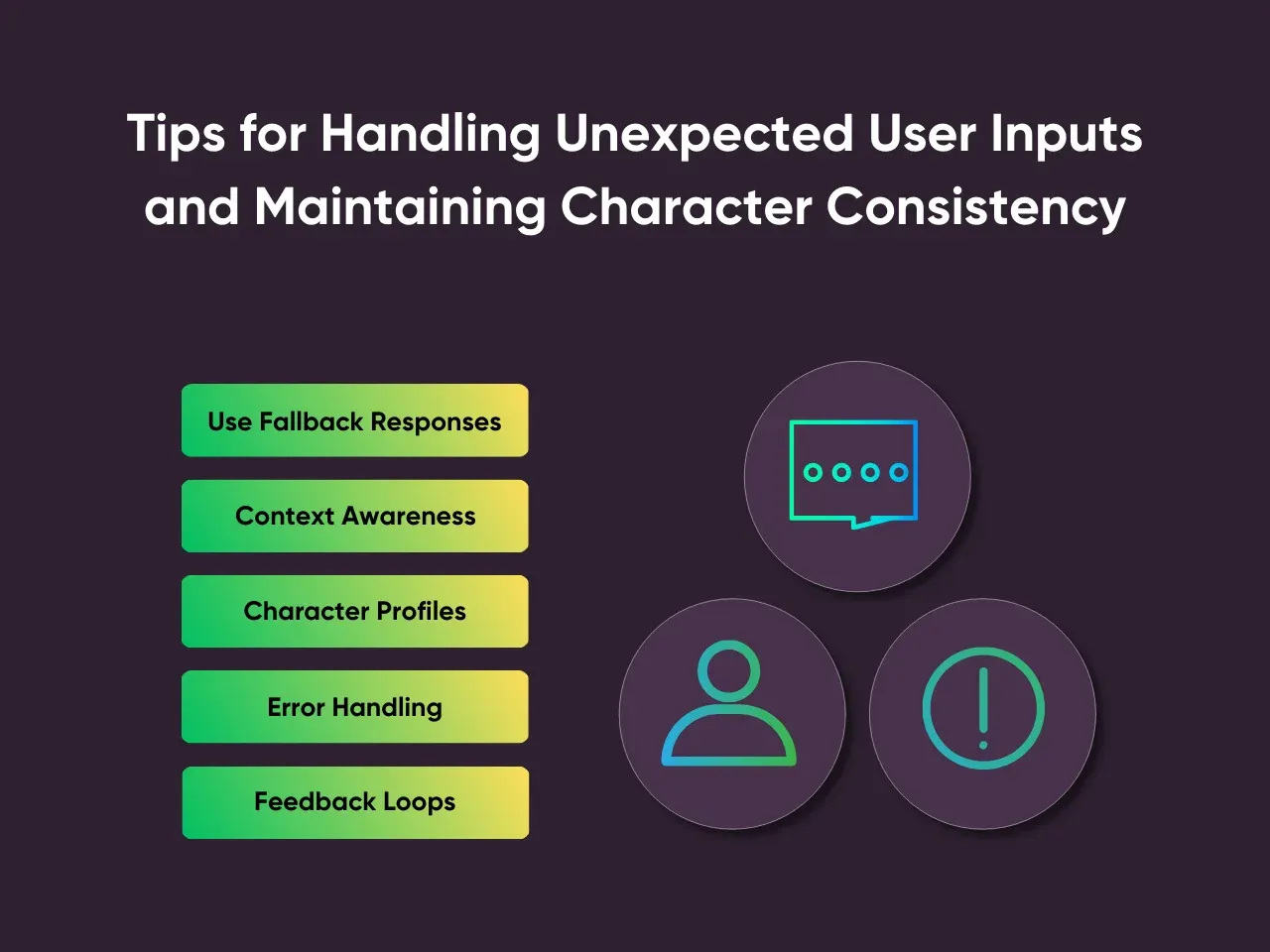
- Use Fallback Responses: When the chatbot doesn’t understand an input, fallback responses can guide the conversation back on track without breaking character.
- Context Awareness: Maintain a conversation history to ensure the chatbot responds in context, avoiding generic or off-topic replies.
- Character Profiles: Create detailed character profiles with defined traits, ensuring the chatbot's responses align with its personality.
- Error Handling: Implement error-handling protocols that allow the chatbot to manage misunderstandings while staying in character gracefully.
- Feedback Loops: Continuously gather user feedback to refine and improve the chatbot’s conversational flows and character portrayal.
Designing effective conversational flows requires a combination of NLP techniques and strategic planning. Focus on handling unexpected inputs and maintaining character consistency to ensure your AI chatbot provides engaging and reliable interactions. This approach enhances user experience and aligns the chatbot's behavior with its intended purpose.
Step 4: Implement Natural Language Processing (NLP)
Training AI chatbots requires precise implementation of Natural Language Processing (NLP). NLP helps chatbots understand and respond to human language naturally and engagingly. Focusing on NLP techniques ensures the chatbot can interpret complex inputs and generate appropriate, context-aware responses. Successful implementation of NLP enhances the chatbot's ability to maintain character consistency, which is crucial in delivering an immersive user experience.
These are the essential key NLP techniques for training AI chatbots:
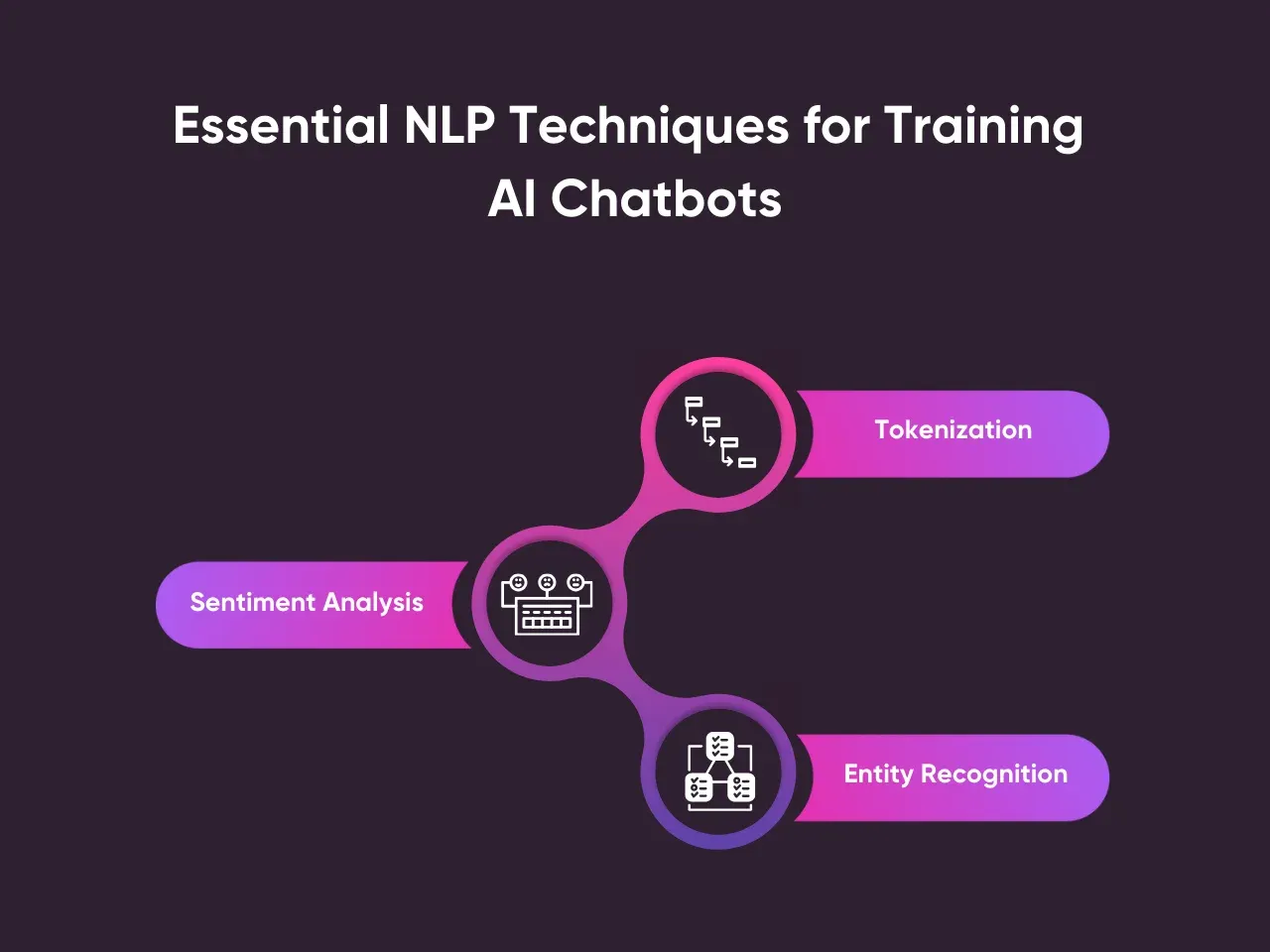
- Tokenization: This process breaks down text into smaller units like words or phrases, helping the chatbot analyze language structure.
- Sentiment Analysis: This technique allows the chatbot to understand the emotional tone of a user's input, enabling more empathetic responses.
- Entity Recognition: This method identifies and categorizes key information in user inputs, such as names, dates, or locations, ensuring accurate and relevant replies.
Training AI chatbots with these techniques improves their understanding of user inputs and strengthens their ability to stay in character. Each technique contributes to the chatbot’s ability to provide responses that align with its intended personality traits, making interactions more engaging.
Step 5: Test and Iterate
Testing plays a critical role in training AI chatbots. After implementing the initial stages, thorough testing helps identify chatbot performance issues. Testing the chatbot with diverse user groups ensures it responds accurately to various inputs. This step ensures the chatbot remains consistent with its intended character traits and delivers a seamless user experience.
Iterating on the feedback gathered during testing is equally important. Refining the chatbot’s responses, adjusting its conversational flow, and fine-tuning its character traits based on real user interactions are necessary. Consistent iteration improves the chatbot’s effectiveness, making it more adaptable and capable of providing high-quality interactions.
Enhance Your Chatbot with Kindroid AI
Enhancing the training of AI chatbots involves integrating advanced tools and platforms that can elevate the chatbot's performance and user interaction. Kindroid AI offers a robust solution for improving bot training, providing a tailored experience that aligns with users' intent and needs.
Below are five ways Kindroid enhances the training process for AI chatbots:
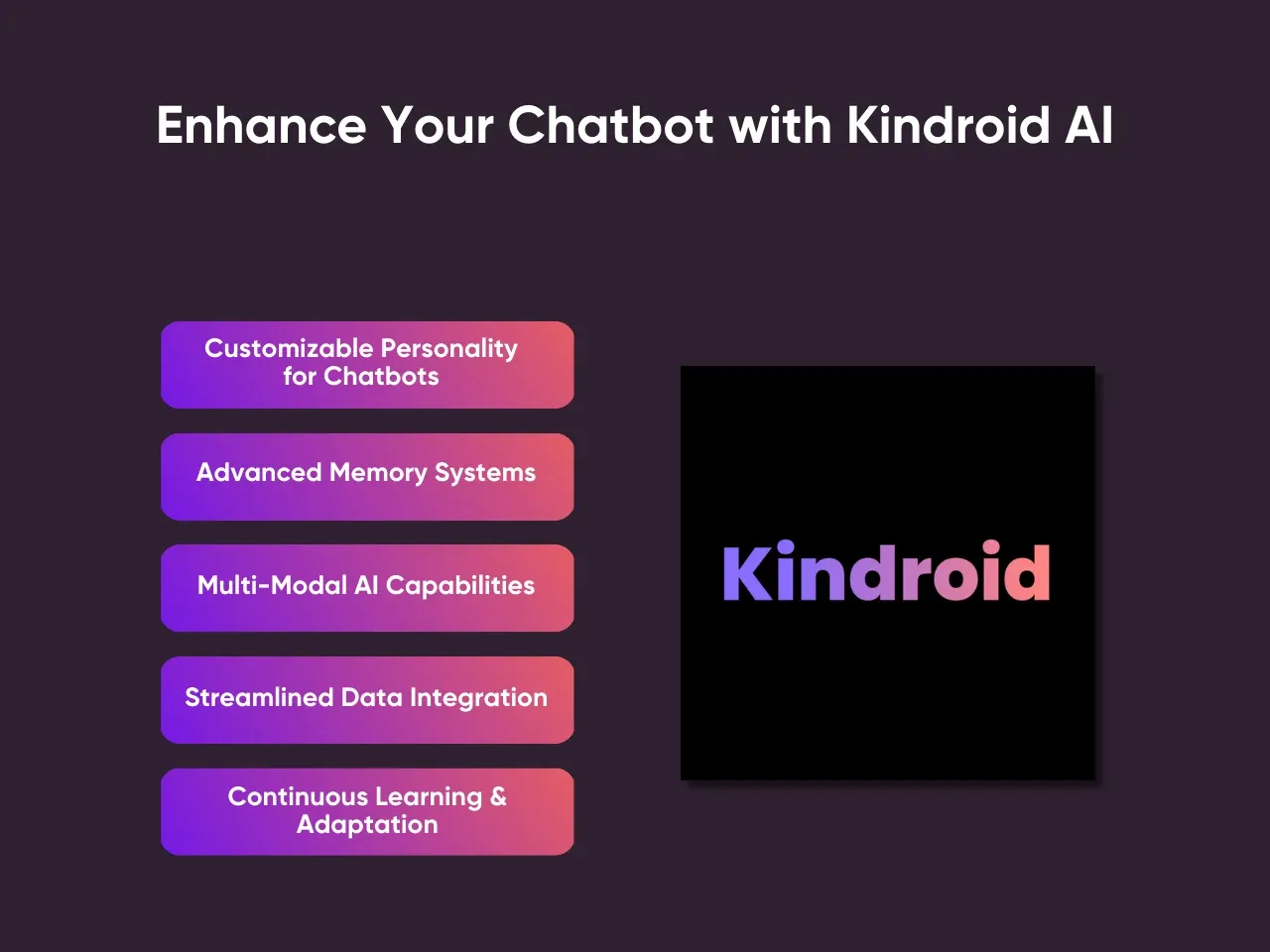
1. Customizable Personality for Chatbots
Kindroid allows developers to create chatbots with customizable personalities, ensuring that each bot aligns with its intended use case. Configuring unique backstories, developers can shape how a chatbot interacts, responds, and evolves during bot training. This feature is precious for chatbots that must handle diverse users' intent and provide personalized experiences across different platforms, including social media and live chat.
2. Advanced Memory Systems
Kindroid AI’s advanced memory system enables chatbots to remember past interactions, making them more responsive to previous examples and able to anticipate future interactions. Leveraging a memory system, a successful chatbot can provide conversation continuity, leading to improved response time and a more natural interaction flow. This feature becomes essential when handling basic questions repeatedly or managing a complex knowledge base.
3. Multi-Modal AI Capabilities
Kindroid supports multi-modal AI, integrating NLP, sentiment analysis, and voice modulation to create a richer user experience. These features help train AI chatbots to understand and interpret various forms of data, from textual inputs to emotional cues, enhancing their ability to engage in more human-like conversations. By combining tokenization and utterance analysis, chatbots trained with Kindroid can handle various scenarios, making them valuable resources in customer support roles.
4. Streamlined Data Integration
Kindroid simplifies the integration of diverse datasets, allowing developers to feed large amounts of relevant data during training. Whether pulling data from Google, API sources, or custom Python scripts, Kindroid ensures that chatbots are well-equipped with the necessary knowledge to handle complex queries. The platform supports various coding templates and code snippets to automate the training process, ensuring that chatbots are trained efficiently and effectively.
5. Continuous Learning and Adaptation
Kindroid enables chatbots to continuously learn from their interactions, adapting to new inputs and evolving responses. This is supported through ongoing AI training and automation processes that adjust the chatbot’s AI model based on user feedback. Whether enhancing a chatbot's ability to handle WhatsApp queries or improving its performance metrics in a specific use case, Kindroid ensures that it remains up-to-date and aligned with the latest user needs.
Key Takeaway
Training AI chatbots demands a structured approach involving clear goals, well-organized data, and precise conversational designs. This process ensures that the chatbots meet functional requirements and deliver exceptional user experiences. Emphasizing character development through advanced techniques such as machine learning models and natural language processing elevates the quality of interactions and creates more engaging, responsive, and lifelike chatbots.
The benefits of well-trained AI chatbots extend beyond basic functionality. Enhanced user experiences through unfiltered AI chat can significantly impact user satisfaction and retention. Businesses can offer a more personalized and immersive experience by creating rich, character-driven interactions. The importance of continuously testing and iterating the chatbot ensures ongoing improvement and relevance.
Would you like to learn more about training AI chatbots? At Kindroid, we assist in developing versatile AI chatbots tailored to your needs. Our expertise ensures your chatbot performs effectively and offers a superior user experience. Discover how Kindroid can help you create the best AI companion app and transform your user interactions.
